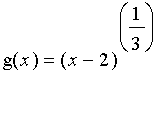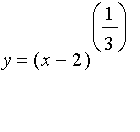Inverse Functions
![]()
A function
![]() is said to be
one-to-one if
is said to be
one-to-one if
![]() whenever
whenever
![]()
Here is a one-to-one function
![[Maple OLE 2.0 Object]](images/suppl_inverseFunction4.gif)
![]()
While the function below is not one-to-one.
![[Maple OLE 2.0 Object]](images/suppl_inverseFunction6.gif)
¡@
Horizontal Line test
A function is one-to-one if and only if no horizontal line intersects its graph more than once. The animation below shows that the function
 is one-to-one.
is one-to-one.
![[Maple Plot]](images/suppl_inverseFunction8.gif)
¡@
If we reverse the inputs and outputs of the function F below,
![[Maple OLE 2.0 Object]](images/suppl_inverseFunction9.gif)
![]()
we get a new function G as follows .
![[Maple OLE 2.0 Object]](images/suppl_inverseFunction11.gif)
¡@
Notice that for all
![]() in
the domain of F , we have
in
the domain of F , we have
![]()
and for all
![]() in
the domain of G , we have
in
the domain of G , we have
![]() .
.
Let ![]() be a one-to-one function with domain
A and range B . Then the inverse function
be a one-to-one function with domain
A and range B . Then the inverse function ![]() has domain B and range A and is defined by
has domain B and range A and is defined by
![]()
for any
![]() in
B.
in
B.
This says that if
![]() maps
maps
![]() to
to
![]() , then its inverse function
, then its inverse function
![]() maps
maps
![]() back
to
back
to
![]() .
.
In the example above , G is the inverse function of F .
Does function H have an inverse function? Why?
![[Maple OLE 2.0 Object]](images/suppl_inverseFunction26.gif)
¡@
How to find the inverse function
![]() of a one-to-one function
of a one-to-one function
![]() ?
?
Step 1
Write
![]() .
.
Step 2
Solve this equation for
![]() in
terms of
in
terms of
![]() .
.
Step 3 To express
![]() as a function of
as a function of
![]() , interchange
, interchange
![]() and
and
![]() , the resulting equation is
, the resulting equation is
![]() .
.
¡@
For example, if we consider the function
 . ( Note that is one-to-one.)
. ( Note that is one-to-one.)
![[Maple Plot]](images/suppl_inverseFunction39.gif)
Solving the equation
 for
for
![]() in
terms of
in
terms of
![]() ,
,

we get that the inverse function is
 .
.
The following figure shows the graphs of
 (red)
and
(red)
and
 (blue).
Note that they are mirror images of each other through the line
(blue).
Note that they are mirror images of each other through the line
![]() (green).
(green).
![[Maple Plot]](images/suppl_inverseFunction49.gif)
¡@
Now we consider what does it mean to invert the sine function. First we note that there is a complication with trigonometric function that did not arise with the functions we have just discussed. The sine function clearly fails the horizontal line test.
![[Maple Plot]](images/suppl_inverseFunction50.gif)
¡@
The following figure shows two periods of the sine function (blue) and the result (red) of interchanging
![]() and
and
![]() in
the equation
in
the equation
![]() .
.
![[Maple Plot]](images/suppl_inverseFunction54.gif)
¡@
The problem is that the red curve is obviously not the graph of a function. In order to have an invertible function that takes all the values of the sine function, we restrict the domain of the sine to the interval from
![]() to
to
![]() .
.
![[Maple Plot]](images/suppl_inverseFunction57.gif)
This restricted sine and its inverse (called arcsine , in Maple we use the command
arcsin(x) ) are shown in the next figure.
![]() (red)
(red)
![]() (blue)
(blue)
![[Maple Plot]](images/suppl_inverseFunction60.gif)
¡@
Here are problems to think about:
If we restrict the domain of sine to [
![]() ,
,
![]() ],
what does the resulting inverse function look like? What is the relation between
this inverse function and
],
what does the resulting inverse function look like? What is the relation between
this inverse function and
![]() ?
?
By restricting the domain of cosine to the interval from
![]() to
to
![]() , we invert cosine in the same fashion. The resulting inverse function is called
arccosine. Note that the domain of both
, we invert cosine in the same fashion. The resulting inverse function is called
arccosine. Note that the domain of both
![]() and
and
![]() are
[
are
[
![]() ,
1 ].
,
1 ].
What is the relation between
![]() and
and
![]() ?
?
If
![]() and
and
![]() , the exponential function is either increasing or decreasing and so it is one-to-one. It therefore has an inverse function which is called the
logarithmic function with base
, the exponential function is either increasing or decreasing and so it is one-to-one. It therefore has an inverse function which is called the
logarithmic function with base
![]() and
is denoted by
and
is denoted by
![]() . Hence
. Hence
![]()
and
 = x](images/suppl_inverseFunction77.gif) for every
for every
![]() ,
,
 = x](images/suppl_inverseFunction79.gif) for every
for every
![]() .
.
Laws of Logarithms
1.
![]()
2.
 = log[a](x)-log[a](y)](images/suppl_inverseFunction82.gif)
3.
 = r*log[a](x)](images/suppl_inverseFunction83.gif) (where
(where
![]() is
any real number)
is
any real number)
The logarithm with base
![]() is
called the natural logarithm and has special notation
is
called the natural logarithm and has special notation
![]() .
.
Hence, we have
![]()
 for every
for every
![]() ,
,
 for every
for every
![]() .
.
In particular,
![]() .
.
The following figure shows the graphs of
 (red)
and
(red)
and
![]() (blue).
Note that they are mirror images of each other through the line
(blue).
Note that they are mirror images of each other through the line
![]() (green).
(green).
![[Maple Plot]](images/suppl_inverseFunction98.gif)